

Lewis and Clark . Native Americans. While Lewis and Clark were the first Americans to see much of what would become the western United States, those same lands had long been occupied by native peoples.

Over the course of the expedition, the Corps of Discovery would come into contact with nearly 50 Native American tribes. Quickly, the captains learned how many different definitions there really were for the word “Indian.” The Mandans lived in earth lodges, farmed corn and were amenable to trade with America. The Teton Sioux slept in tepees, hunted buffalo and guarded their territory fiercely against anyone who passed through, whether foreign or Indian. Some tribes had never seen a white or black man before Lewis and Clark. Indian removal. Early in the 19th century, while the rapidly-growing United States expanded into the lower South, white settlers faced what they considered an obstacle.

Indian-Pioneer Papers Collection. US History Scene. American Indian Tribes Map. Abenaki Acoma Algonquin Anishinaabe Apache Arapaho Assiniboine Athabascan Aztec Blackfeet Blackfoot Caddo Cayuga Cheraw Cheyenne Chickasaw Chicora Chinook Chippewa Choctaw Chumash Coeur d'Alene Comanche Costanoan Cree Creek (Muskogee) Crow Dakota Delaware Dene Edisto Euchee Flathead Gros Ventre Gwitchan Haida Haudenosaunee Havasupai Hidatsa Ho-Chunk Hopi Huron Iowa Iroquois Kaw Kawaiisu Kickapoo Kiowa Lakota Lenape Lumbee Maliseet Mandan Mattaponi Maya Menominee Metis MicMac Mojave Mohawk Mohegan Mohican Monacan Muscogee Nanticokes Narragansett Navajo Nez Perce Nipmuc Odawa Ohlone Ojibwe Omaha OneidaOnondaga Osage Paiute Pima Ponca Potawatomi Powhatan Pueblo Quapaw Sac Salish Seminole Seneca Shawnee Shinnecock ShoshoneSioux Tsalagi Tuscarora Ute Wea Wichita Winnebago Wyandot Yavapai Yokut Zuni " I was born upon the prairie where the wind blew free, and there was nothing to break the light of the sun.
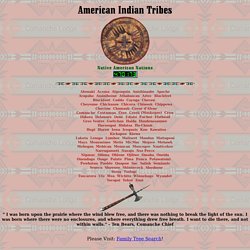
I was born where there were no enclosures, and where everything drew free breath. Maps of Native American Tribes and Reservations in the United States. Native Intelligence. On March 22, 1621, a Native American delegation walked through what is now southern New England to meet with a group of foreigners who had taken over a recently deserted Indian settlement.
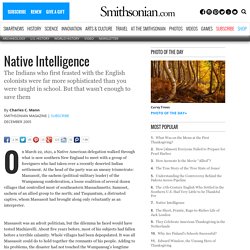
At the head of the party was an uneasy triumvirate: Massasoit, the sachem (political-military leader) of the Wampanoag confederation, a loose coalition of several dozen villages that controlled most of southeastern Massachusetts; Samoset, sachem of an allied group to the north; and Tisquantum, a distrusted captive, whom Massasoit had brought along only reluctantly as an interpreter. Massasoit was an adroit politician, but the dilemma he faced would have tested Machiavelli. About five years before, most of his subjects had fallen before a terrible calamity.
Whole villages had been depopulated. It was all Massasoit could do to hold together the remnants of his people. Europeans had been visiting New England for at least a century. "A Friendly Indian" Native American Indian Legends A-B. Black Hawk War of 1832. By James Lewis, Ph.D.

Native American populations descend from three key migrations, scientists say. Scientists have found that Native American populations -- from Canada to the southern tip of Chile -- arose from at least three migrations, with the majority descended entirely from a single group of First American migrants that crossed over through Beringia, a land bridge between Asia and America that existed during the ice ages, more than 15,000 years ago.
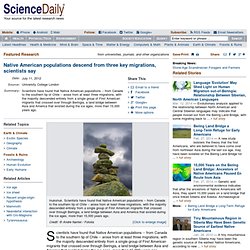
By studying variations in Native American DNA sequences, the international team found that while most of the Native American populations arose from the first migration, two subsequent migrations also made important genetic contributions. The paper is published in the journal Nature July 11. "For years it has been contentious whether the settlement of the Americas occurred by means of a single or multiple migrations from Siberia," said Professor Andres Ruiz-Linares (UCL Genetics, Evolution and Environment), who coordinated the study. "But our research settles this debate: Native Americans do not stem from a single migration. DNA Analysis Shows Native American Genealogy. Fight the Power: 100 Heroes of Native Resistance, Part 1. There were many Native heroes and many who resisted; here are a few from the 1700s and 1800s: Dragging Canoe, born around 1738, was a Cherokee war chief.
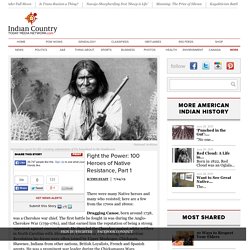
The first battle he fought in was during the Anglo-Cherokee War (1759-1761), and that earned him the reputation of being a strong opponent against encroachment. He then led the Cherokee against white settlers in North Carolina with Abraham of Chilowee in 1776. During the American Revolution his forces were often joined by Upper Muskogee, Chickasaw, Shawnee, Indians from other nations, British Loyalists, French and Spanish agents. He was a prominent war leader during the Chickamauga Wars (1776-1794). Dragging Canoe was a prominent Cherokee war chief.
Tecumseh, born in 1768, was a Shawnee leader who not only resisted, he tried to unite all Native Americans so they could defend themselves against the growing United States. Tecumseh, a Shawnee leader, tried to united all Natives against the growing United States. The American Revolution. American Indians and the American Revolution by Collin G.
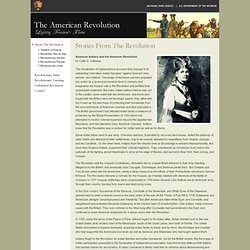
Calloway The Declaration of Independence accused King George III of unleashing "merciless Indian Savages" against innocent men, women, and children. The image of ferocious warriors propelled into action by a tyrannical monarch fixed in memory and imagination the Indians' role in the Revolution and justified their subsequent treatment.